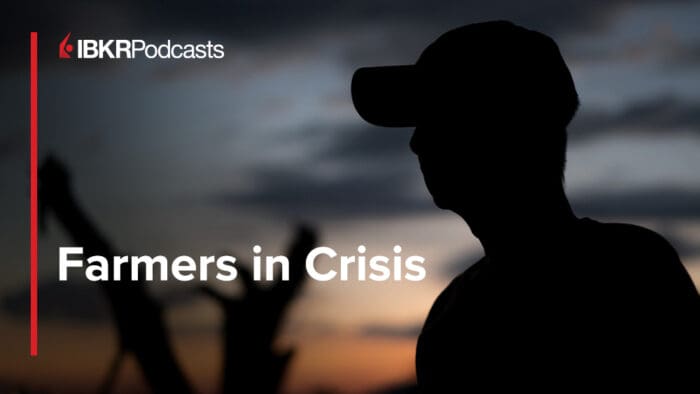Crop conditions have never been better. But that’s not necessarily good news for farmers. Dan Basse, CEO of AgResource, joins IBKR’s Andrew Wilkinson to discuss.
Summary – IBKR Podcasts Ep. 189
The following is a summary of a live audio recording and may contain errors in spelling or grammar. Although IBKR has edited for clarity no material changes have been made.
Andrew Wilkinson
Welcome to today’s podcast. My name is Andrew Wilkinson, and I’m joined by Dan Basse, CEO of AgResource over in Illinois. Today’s episode, we’ll be talking all about crop progress in the Midwest. Dan, welcome. How are you?
Dan Basse
I’m really well, how have you been? The summer’s gone too fast, but other than that, it’s all good.
Andrew Wilkinson
It’s definitely cooling down here as we record this in the first week of September.
Dan, tell me, first of all, conditions have been what you might describe as perfect for the 2024 harvest, but in itself that creates bad news for farmers, doesn’t it? Can you describe the crop progress for the audience, please?
Dan Basse
Yeah, no, it really does. When we look back in the key two growing months for the U.S. crops, and I’m now talking about corn and soybeans and sorghum, our principal row crops, it’s really July and August, which June, July, and August are the three principal months. But June and July are really the key.
The U. S. was the second warmest on record, but it was warm on each coast. The east and the west. In the fat part of the central U. S., we had temperate conditions. And then we got very fortunate. We got a hurricane named Beryl that barreled up the Midwest, the Mississippi River, to be exact. And it gave us just the right amount of water at the right time as corn was reproducing.
And set us up for a record U.S. corn and soybean yield. So, it’s a bounteous year. We’re looking at big crops, and Mother Nature was really big part of it because we had this stagnant weather pattern, which produced mild temperatures and mostly good rain. Though, it’s getting a little dry now, but that’s okay heading into harvest.
Andrew Wilkinson
Great conditions, bounteous crops and harvest means lower prices, but that’s not the only influence from the supply side, right? What about events outside of the United States for U. S. farmers? I’m thinking here about the success of Brazilian crops, maybe flooding the markets, and how China might be less reliant on U. S. exports. Talk a little bit about those external factors for the audience, please.
Dan Basse
Yeah, no, you’re right. Yeah, you know, again Brazil did have good crops last year also. They’ve got multiple crop seasons in Brazil, so it’s always a little hard to say each year, but nonetheless when you think about Brazil, it is a keen competitor of the United States and the United States farmer.
And then I think what you’re highlighting is this thing called the duopoly in world power, where it used to be the geopolitics of the world was centered on Washington, D.C., And now it’s Beijing and Washington, D.C. And there’s this competitive influence between the two of them.
China is the world’s largest food importer, taking about $234 billion last year. That’s $1.4 trillion in total trade. And of that, 10% of that came from the United States, or a little more than that. And so they were our largest agricultural customer. Boiling it down today, China’s gone to Brazil, and so the BRICS, if you will, Brazil, Russia, India, and China are getting somewhat stronger on agricultural trade.
And China’s now focusing a lot of its corn demand and soybean demand on Brazil, leaving U. S. farmers with less demand. Mexico’s come along to some degree to help us out, but not enough to really replace our biggest customer named China.
Andrew Wilkinson
Just put that in perspective in terms of prices. Where are prices for those key crop products, Dan?
Dan Basse
Yeah, so today the corn market in Chicago fell to a new four year low. In other words, we haven’t been this low since the pandemic started back in 2019, below $4 a bushel. Chicago futures made it down to about $3.60 a bushel. And in terms of soybeans, also the same case. We fell below you know, $9.50 a bushel have not been this low looking backwards at 2019.
And so, the demand in terms of U.S. Ag trade is meaningful. USDA just came out and said that at least the U.S. had a trade deficit, Ag trade deficit of a record large $42.5 billion last year. that trade deficit back to where it should be, which is A positive, we’d have crop prices that would be far higher.
Corn would be back above $5.00. Soybeans back above $11.00. And a U.S. farmer would have a big crop at a reasonably good price. Unfortunately, that’s not the case as we head into the harvest today.
Andrew Wilkinson
Dan, just talk a little bit about the cost side of the equation. Things that farmers have to pay for. I’m thinking of labor, seeds and fertilizer and so on.
Dan Basse
You know, I was at a big farm meeting yesterday, and that was the big topic at the meeting, which is, the price of a John Deere tractor, hundreds of thousands of dollars. The price of a John Deere or any combine, for that matter, a half million dollars. And so, agriculture is a very capital intensive business when you consider farmland, selling at $10,000 to $20,000 an acre and all the inputs that need to go into a crop.
If I kind of back it out and look at where the U.S. farmer is this year, his break even cost on a big basis or a nationwide basis is about $4.69 a bushel on corn. So a price of $4.70 in Chicago would indicate that farmers are losing about a $1.00 a bushel on corn. The case of soybeans, we think it’s about $11.90 a bushel.
So prices in Chicago of, $9.90 a bushel would give him about a $2.00 loss. And these are the kind of disastrous decisions that are going on in the ag economy. As you think about the farmer, it’s not a good year. He’s trying to figure out how he’s going to make it through to the next year and where he can trade down or cut costs for the 2025 crop.
Farmers are not happy at the moment, just relative to market conditions and a lot of that’s related back to trade, but also the bounteous harvest he’s going to have this year.
Andrew Wilkinson
And anything on seed costs and fertilizer costs? We’ve still got the Ukraine-Russia conflict going on in the background as well, right?
Dan Basse
We do have Russia and Ukraine in the background, but U.S. seed costs are estimated by the American Seed Trade Association to be up about 8% this year. Fertilizer prices are estimated to be up 4-7%. Some of that is related to China no longer exporting a nitrogen source called urea, and also cutting back on phosphate exports.
China was a big supplier of phosphate to the United States. And so, you know, putting it all together, this geopolitical squeeze of the competitiveness between Washington and Beijing really plays out in many sectors on the farm, both from the fertilizer side of it, a little bit to seed as well. China’s now, of course, adopting GM seed itself.
And then, of course, looking forward to the actual imports and where China buys from.
Andrew Wilkinson
I read earlier this year, or read the University of Illinois earlier this year, calculated farmers in the state of Illinois are projected to lose $118.00 per acre. I’ve planted corn and $81.00 per acre of soybeans. February USDA projected a drop in farm income of a quarter from compared to last year, unless prices improved.
So it’s pretty dire out there.
Dan Basse
It really is. I don’t want to diminish it. When you’re losing $100.00 an acre on average between corn and soybeans, and I think the Illinois figures would be a little larger now it’s a pretty tough situation. And it’s not only today, but what do farmers do to manage either costs or their margin going forward?
So, the only good news in the background of all of this domiciled on U.S. farmers. Brazilian farmers, even with their weakening currency, the Real, are also losing money. So, we calculated at around R$1,500, the Brazilian farmers losing, not as much as U.S. farmer, that’d be about $47.00 an acre.
But nonetheless, it still is a loss. And so, this is a global phenomenon, if you will, in farm income. Everywhere we look, whether it’s Europe or the places like Latin America or the United States and even China crop prices there are not well. And so with that, China’s not importing, at least telling its importers not to buy much corn and less soybeans to make it through to the next cycle.
Andrew Wilkinson
How far can prices keep sliding? Is there a flaw here, Dan? Will farmers ultimately switch to less fertilizer intensive soybean crops for next year? And that then caused potential shortfall in corn grants?
Dan Basse
Yeah, no, that’s the discussion of the farmer, which is where does he trade down to? Can he find nontraded or cheaper corn seed or soybean seed that’s more conventional? Can he trade down and maybe use less fertilizer? Can he go to his landowner and say, can I pay you a lower rent? These are all kind of the discussions and of course he’s probably not going to be buying that John Deere tractor or combine at least this year, maybe he leases it.
So those are the discussions that are ongoing, but, you know, it’s still hard with the markets, where they’re at, to pencil out a profit. So, USDA was out today and they did raise farm income a little bit, but it’s largely due to the species, the dairy industry, the livestock industries, that benefit from lower feed costs, it’s not the grain farmers specifically.
Andrew Wilkinson
Dan Basse, CEO of AgResource in Chicago. Thank you very much for joining me today
Dan Basse
You’re very welcome.
Andrew Wilkinson
And to the audience, don’t forget to look out for more podcasts from wherever you download your podcasts and don’t forget to subscribe if you like what we do. Thanks everybody. Bye for now.
Disclosure: Interactive Brokers
The analysis in this material is provided for information only and is not and should not be construed as an offer to sell or the solicitation of an offer to buy any security. To the extent that this material discusses general market activity, industry or sector trends or other broad-based economic or political conditions, it should not be construed as research or investment advice. To the extent that it includes references to specific securities, commodities, currencies, or other instruments, those references do not constitute a recommendation by IBKR to buy, sell or hold such investments. This material does not and is not intended to take into account the particular financial conditions, investment objectives or requirements of individual customers. Before acting on this material, you should consider whether it is suitable for your particular circumstances and, as necessary, seek professional advice.
The views and opinions expressed herein are those of the author and do not necessarily reflect the views of Interactive Brokers, its affiliates, or its employees.
Disclosure: Futures Trading
Futures are not suitable for all investors. The amount you may lose may be greater than your initial investment. Before trading futures, please read the CFTC Risk Disclosure. A copy and additional information are available at ibkr.com.



















Join The Conversation
If you have a general question, it may already be covered in our FAQs. If you have an account-specific question or concern, please reach out to Client Services.